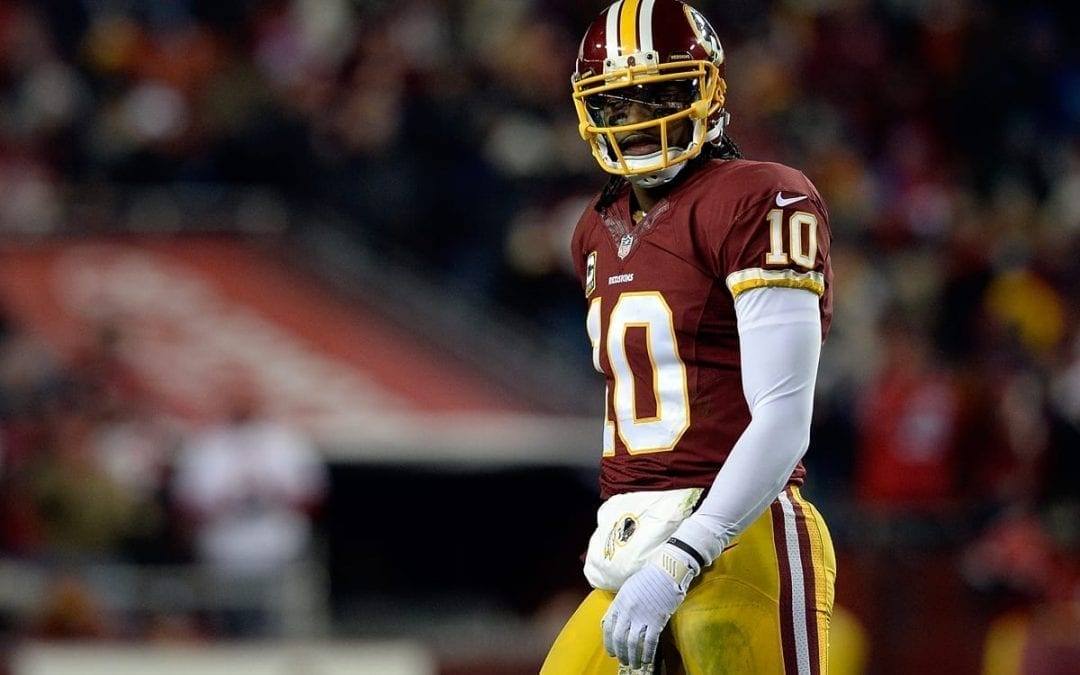With March soon to turn into April, the churn of the NFL offseason has begun to slow. While the Baltimore Ravens have remained relatively quiet since landing All-Pro safety Eric Weddle a week ago, other members of the AFC North have made some waves of late. In particular, the Cleveland Browns signed former No. 2 overall pick Robert Griffin III to boost their lackluster quarterback position.
For the majority of his four-year career, Griffin has proven a polarizing force. A rookie sensation in 2012, he helped Washington to its first division title since Hall of Fame coach Joe Gibbs roamed the sidelines. However, an ACL tear suffered during the team’s wild-card round loss to the Seattle Seahawks sent Griffin’s career spiraling. He returned in time for the season opener the following year, but the explosive plays and decisive play that characterized his rookie campaign never rematerialized. Washington sunk to the bottom of the NFC East, leading to Dan Snyder and Bruce Allen gutting the coaching staff.
[Discuss this article on the BSL message board here]
Out went Mike Shanahan, replaced by Jay Gruden, who never seemed particularly thrilled about the prospect of working with Griffin. The two never got on the same page, with the headman benching Griffin before the 2015 season for Kirk Cousins, effectively ending the one-time Offensive Rookie of the Year’s tenure in D.C. Though the team picked up his fifth-year option last year, they elected to cut Griffin just as the NFL’s free agency period began in early March.
With Griffin’s stock at an all-time low, few teams expressed much interest in him on the open market. The New York Jets brought Griffin in for a visit, though it quickly became clear they only met with him to apply pressure on Ryan Fitzpatrick, their starter during 2015 who remains unsigned. The reigning-champion Denver Broncos made contact, though they quickly moved onto other options. That left only the Browns, at least in terms of those publicly connected with Griffin.
For the Browns, Griffin provides at least the prospect of excitement at the quarterback position, an element severely lacking in Cleveland since the team returned from oblivion in 1999. While Griffin hasn’t played well since his rookie year — he has completed 62.8 percent of his passes for 4,897 yards, 20 touchdowns and 18 interceptions while rushing for 665 yards and just one score on 124 carries since the start of 2013 — the physical tools that made him the most intriguing quarterback prospect to emerge from the college ranks since Michael Vick remain mostly intact. A capable offensive coach, which many hold new Cleveland headman Hue Jackson to be, can unlock those traits by adjusting the scheme around Griffin’s strengths.
At the same time, the Browns still appear likely to use an early draft selection on a quarterback despite Griffin’s presence. The same day the team signed RGIII, it’s coaching staff spent the day in Fargo, N.D. to work out signal-caller Carson Wentz. Wentz falls into a more traditional mold, possessing a strong arm and doing most of his work from within the confines of the pocket. The possibility exists that Wentz, or a top prospect like Cal’s Jared Goff, could share a quarterback room with Griffin this season.
In the short run, this could lead to plenty of confusion in Cleveland. Griffin remains young — he turned 26 shortly after Super Bowl 50 — and still has time to right his career after exorcising himself out of the often-toxic environment in Washington. However, the Browns’ new front office and coaching staff can’t realistically invest the necessarily resources in Griffin if they spend a top-10 pick on another signal-caller. In such a scenario, the team would seem unlikely to dig its way out of the AFC North cellar in 2016.
However, other franchises have found success by investing in multiple quarterbacks simultaneously and allowing the situation to play out over a few years. Not long ago, the San Diego Chargers invested two early picks in Drew Brees and Philip Rivers within three years of each other, a difference similar to that between Griffin and the signal-callers in this year’s draft class. Brees’ play improved through competition with Rivers, who developed out of the spotlight in the interim. San Diego ultimately allowed Brees to walk in 2006, with Rivers taking over without missing a beat.
While the situation in Cleveland differs in several areas, the idea of not placing the entire weight of the franchise on just one option makes some sense. If Griffin falters, the Browns would have a viable alternative to step into his place. In the alternative, a strong performance by RGIII allows the team to either continue with him under center or see what it can acquire for him in a trade.
AFC North rivals like the Ravens don’t have to worry about a suddenly competent Browns just yet. Cleveland hasn’t shown that it can identify and secure the right players through the draft, and it remains possible that both Griffin and any quarterback brought in could fail. However, the Browns have at least diversified their risk, a strategy that seemed alien to the organization as recently as last season.

Jason B. Hirschhorn is an award-winning sports journalist and Pro Football Writers of America member. He has bylines at NFL.com, SB Nation, Sports Illustrated, and other outlets.
